Post-Soviet states
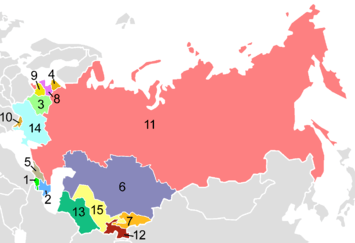
The post-Soviet states, also collectively known as the former Soviet Union (FSU)[1] or former Soviet Republics, are the states that emerged and re-emerged from the Union of Soviet Socialist Republics in its breakup in 1991, with Russia internationally recognised as the successor state to the Soviet Union after the Cold War. The three Baltic states were the first to declare their independence, between March and May 1990, claiming continuity from the original states that existed prior to their annexation by the Soviet Union in 1940.[2][3] The remaining 12 republics all subsequently seceded.[2] 12 of the 15 states, excluding the Baltic states, initially formed the CIS and most joined CSTO, while the Baltic states focused on European Union and NATO membership.
Several disputed states with varying degrees of recognition exist within the territory of the former Soviet Union: Transnistria in eastern Moldova, Abkhazia and South Ossetia in northern Georgia and Nagorno-Karabakh in southwestern Azerbaijan. Since 2014, the Donetsk People's Republic and Luhansk People's Republic in Eastern Ukraine have claimed independence. All of these unrecognised states except Nagorno-Karabakh depend on Russian armed support and financial aid. Nagorno-Karabakh is integrated to Armenia, which also maintains close cooperation with Russia. Prior to the annexation of Crimea to Russia in March 2014, which is not recognized by most countries, it briefly declared itself an independent state.
Country comparison
States and geographical groupings

The 15 post-Soviet states are typically divided into the following five groupings. Each of these regions has its own common set of traits, owing not only to geographic and cultural factors but also to that region's history in relation to Russia. In addition, there are a number of de facto independent, but internationally unrecognized states (see the section Separatist conflicts below).
General statistics
| Country | Coat of arms | Flag | Capital | Independence | Area (km²) | Area (mi²) | Population | Density (pop./km²) | Density (pop./mi²) | Date | Population source |
|---|---|---|---|---|---|---|---|---|---|---|---|
| Russia (Russian Federation) |
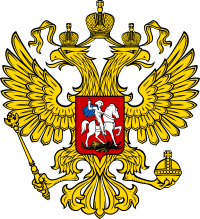 |
 |
Moscow | 1991-12-12[4] | 17,098,242 | 6,601,668 | 146,880,432 | 8.59 | 22.2 | January 1, 2018 | Official estimate |
| Ukraine[5] |  |
 |
Kiev | 1991-08-24 | 603,628 | 233,062 | 45,377,581 | 75 | 194 | April 1, 2014 | Monthly official estimate |
| Belarus (Republic of Belarus) |
.svg.png) |
 |
Minsk | 1991-08-25 | 207,600 | 80,155 | 9,765,469 | 46 | 119 | July 1, 2014 | Quarterly official estimate |
| Uzbekistan (Republic of Uzbekistan) |
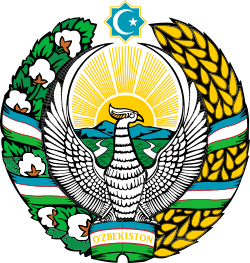 |
 |
Tashkent | 1991-08-31 | 444,103 | 171,469 | 30,492,800 | 69 | 179 | January 1, 2014 | Official estimate |
| Kazakhstan (Republic of Kazakhstan) |
 |
 |
Astana | 1991-12-16 | 2,724,900 | 1,052,090 | 17,186,000 | 6.31 | 16 | February 1, 2014 | Monthly official estimate |
| Georgia | 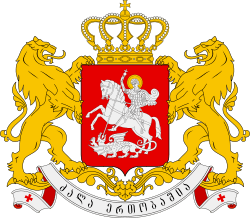 |
 |
Tbilisi (executive) Kutaisi (legislative) |
1991-04-09 | 69,700 | 26,911 | 4,490,500 | 64 | 166 | January 1, 2014 | Official estimate |
| Azerbaijan (Republic of Azerbaijan) |
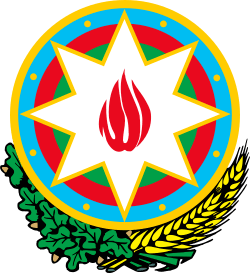 |
 |
Baku | 1991-08-30 | 86,600 | 33,436 | 9,477,100 | 109 | 282 | December 31, 2013 | Official estimate |
| Lithuania (Republic of Lithuania) |
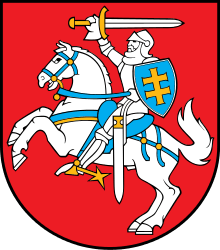 |
 |
Vilnius | 1918-02-16 (current) 1990-03-11 (restored) |
65,300 | 25,212 | 2,944,459 | 45 | 117 | January 1, 2014 | Monthly official estimate |
| Moldova (Republic of Moldova) |
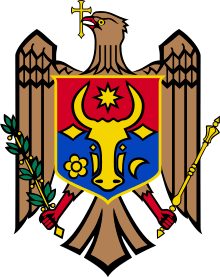 |
 |
Chișinău | 1991-08-27 | 33,843 | 13,067 | 3,550,900 | 105 | 272 | January 1, 2017 | Official estimate |
| Latvia (Republic of Latvia) |
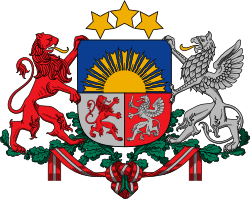 |
 |
Riga | 1918-11-18 (current) 1991-08-21 (restored) |
64,562 | 24,928 | 2,005,200 | 31 | 80 | January 1, 2014 | Monthly official estimate |
| Kyrgyzstan (Kyrgyz Republic) |
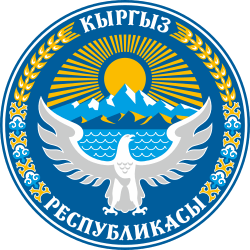 |
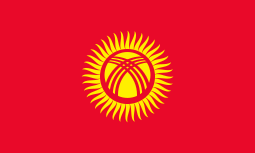 |
Bishkek | 1991-08-31 | 199,945 | 77,199 | 5,895,100 | 29.5 | 76 | 2015 | Official estimate |
| Tajikistan (Republic of Tajikistan) |
 |
 |
Dushanbe | 1991-09-09 | 143,100 | 55,251 | 8,160,000 | 57 | 148 | January 1, 2014 | Official estimate |
| Armenia (Republic of Armenia) |
 |
 |
Yerevan | 1991-09-21 | 29,743 | 11,484 | 3,024,100 | 102 | 264 | 2012 | Official estimate |
| Turkmenistan | 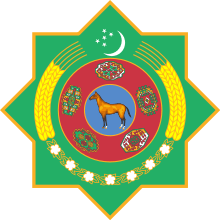 |
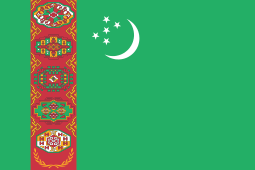 |
Ashgabat | 1991-10-27 | 491,210 | 189,657 | 5,240,000 | 10.7 | 27.7 | July 1, 2013 | UN estimate |
| Estonia (Republic of Estonia) |
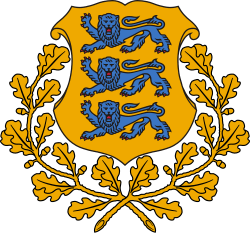 |
 |
Tallinn | 1918-02-24 (current) 1991-08-20 (restored) |
45,339 | 17,505 | 1,313,271 | 29 | 75 | January 1, 2015 | Official estimate |
 |
 |
Moscow | 1991-12-26 | 22,307,815 | 8,613,096 | 292,610,734 | 13.1 | 34 | Various Dates | Various Sources |
Area includes land and water.
Current leaders
Heads of state
Heads of government
Economy
The dissolution of the Soviet Union took place as a result and against the backdrop of general economic stagnation, even regression. As the Gosplan, which had set up production chains to cross SSR lines, broke down, the inter-republic economic connections were also disrupted, leading to even more serious breakdown of the post-Soviet economies.
Most of the formerly Soviet states began the transition to a market economy from a command economy in 1990-1991 and made efforts to rebuild and restructure their economic systems, with varying results. In all, the process triggered severe economic declines, with Gross Domestic Product (GDP) dropping by more than 40% overall between 1990 and 1995.[7] This decline in GDP was much more intense than the 27% decline that the United States suffered in the wake of the Great Depression between 1930 and 1934.[8] The reconfiguration of public finance in compliance with capitalist principles resulted in dramatically reduced spending on health, education and other social programs, leading to a sharp increase in poverty and economic inequality.[9][10] The economic shocks associated with wholesale privatization resulted in the excess deaths of roughly 1 million working age individuals throughout the former Soviet bloc in the 1990s.[11][12] A study by economist Steven Rosefielde asserts that 3.4 million Russians died premature deaths from 1990 to 1998, partly as the result of "shock therapy" imposed by the Washington consensus.[13]
The initial transition decline was eventually arrested by the cumulative effect of market reforms, and after 1995 the economy in the post-Soviet states began to recover, with GDP switching from negative to positive growth rates. By 2007, 10 of the 15 post-Soviet states had recovered and reached GDP greater than what they had in 1991.[14] Only Moldova, Ukraine, Georgia, Kyrgyzstan, and Tajikistan had GDP significantly below the 1991 level. The recovery in Russia was marginal, with GDP in 2006-2007 just nudging above the 1991 level. Combined with the aftershocks of the 1998 economic crisis it led to a return of more interventionist economic policies by Vladimir Putin's administration. Some academic studies show that many former Soviet Republics and Warsaw Pact countries still have not caught up to their levels of output during the twilight of the Soviet era.[15][16]
Change in Gross Domestic Product (GDP) in constant prices, 1991-2015[17]
| Country | 1991* | 1996 | 2001 | 2006 | 2011 | 2015 | Turnaround year** |
|---|---|---|---|---|---|---|---|
| Eastern European states | |||||||
| Russia | 100 | 63.1 | 74.5 | 103.3 | 118.3 | 119.8 | 1997 |
| Ukraine | 100 | 47.2 | 51.8 | 73.7 | 75.9 | 63.4 | 2000 |
| Belarus | 100 | 67.9 | 94.0 | 141.5 | 192.5 | 193.9 | 1996 |
| Moldova | 100 | 45.2 | 45.0 | 62.5 | 74.5 | 83.2 | 1997 |
| Baltic states | |||||||
| Estonia | 100 | ? | ? | ? | ? | ? | ? |
| Latvia | 100 | 67.8 | 92.9 | 143.1 | 130.1 | 145.8 | 1993 |
| Lithuania | 100 | 64.6 | 81.5 | 119.8 | 123.9 | 139.6 | 1995 |
| Central Asia | |||||||
| Kazakhstan | 100 | 69.3 | 88.5 | 141.4 | 185.7 | 219.0 | 1996 |
| Kyrgyzstan | 100 | 58.9 | 76.1 | 89.6 | 114.4 | 133.9 | 1996 |
| Tajikistan | 100 | 34.1 | 45.2 | 56.0 | 98.1 | 124.5 | 1997 |
| Turkmenistan | 100 | 68.4 | 107.7 | 215.5 | 351.8 | 515.5 | 1998 |
| Uzbekistan | 100 | 82.9 | 102.6 | 137.5 | 208.4 | 281.2 | 1996 |
| Transcaucasus | |||||||
| Armenia | 100 | 63.3 | 84.2 | 154.7 | 172.5 | 202.6 | 1994 |
| Azerbaijan | 100 | 42.7 | 65.2 | 150.2 | 241.1 | 276.5 | 1996 |
| Georgia | 100 | 39.8 | 49.8 | 74.1 | 93.2 | 109.3 | 1995 |
*Economy of most Soviet republics started to decline in 1989-1990, thus indices for 1991 don't match pre-reform maximums.
**The year when GDP decline switched to GDP growth.
List of the present Gross domestic product (GDP) (figures are given in 2013 United States dollars for the year 2013 according to The World Factbook[18][19][20][21]):
| No. | Country | nominal millions |
nominal per capita |
PPP millions |
PPP per capita |
|---|---|---|---|---|---|
| 1 | 2,113,000 | 14,600 | 2,553,000 | 18,100 | |
| 2 | 175,500 | 3,800 | 337,400 | 7,400 | |
| 3 | 69,240 | 7,500 | 150,400 | 16,100 | |
| 4 | 55,180 | 1,900 | 112,600 | 3,800 | |
| 5 | 224,900 | 12,700 | 243,600 | 14,100 | |
| 6 | 15,950 | 3,200 | 27,300 | 6,100 | |
| 7 | 76,010 | 7,900 | 100,400 | 10,800 | |
| 8 | 46,710 | 15,300 | 67,430 | 22,600 | |
| 9 | 7,880 | 2,200 | 12,680 | 3,600 | |
| 10 | 30,380 | 15,400 | 38,870 | 19,100 | |
| 11 | 7,234 | 1,300 | 14,300 | 2,500 | |
| 12 | 8,537 | 1,000 | 19,000 | 2,300 | |
| 13 | 10,440 | 3,400 | 20,610 | 6,300 | |
| 14 | 40,560 | 7,900 | 55,160 | 9,700 | |
| 15 | 24,280 | 18,300 | 29,940 | 22,400 |
Developmental progress
The post-Soviet states listed according to their Human Development Index scores in 2016 (the report was launched on 21 March 2017).[22]
Very High Human Development:
High Human Development:







Medium Human Development:




Regional organizations
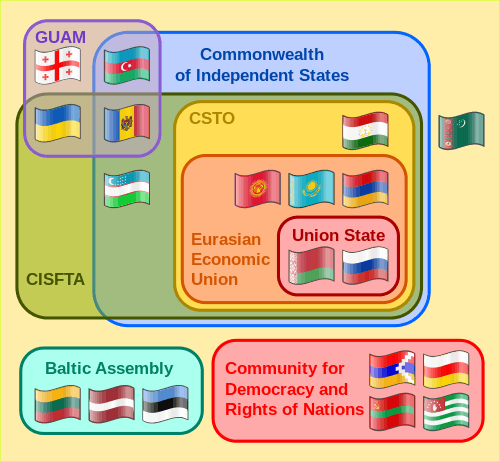
A number of regional organizations and cooperating blocs have sprung up since the dissolution of the Soviet Union. Only organizations that are mainly (or completely) composed of post-Soviet states are listed in this section; organizations with wider memberships are not discussed. The 15 post-Soviet states are divided in their participation to the regional blocs:
- Belarus, Russia, and Ukraine founded the Commonwealth of Independent States (CIS) in December 1991. It was conceived as a successor organization to the USSR, and in December 1993 it included 12 of the 15 former Soviet republics (except the three Baltic states).[23] It currently consists of nine of the 15 former Soviet republics, with one participating state (Ukraine) and one associate state (Turkmenistan). Georgia withdrew from the CIS in August 2008.
- The three Baltic states have not sought membership in any of these post-Soviet organizations, seeking and achieving membership in the European Union and NATO instead, although their electricity and rail systems remain closely connected with former Soviet organizations. The sole exception to the above has been their recent membership in the Community of Democratic Choice.
- The Central Asian states of Kazakhstan, Kyrgyzstan, Tajikistan, and Uzbekistan (as well as Belarus) are members of the CIS and participate in several regional organizations that have Russia as a primary mover. Such organizations are the Eurasian Economic Community (later merged with Eurasian Economic Union, which Tajikistan and Uzbekistan are not members of), Collective Security Treaty Organization, and the Shanghai Cooperation Organization. The last two groups only became distinct once Uzbekistan withdrew from GUAM and sought membership in EurAsEc and CSTO (which it subsequently withdrew from in 2008 and 2012, respectively).
- Armenia, besides its membership in CIS participates in Collective Security Treaty Organization and the Eurasian Economic Union.
- Ukraine, Moldova, and Azerbaijan participate in the CIS but other than that they mostly cooperate within regional organizations that are not dominated by Russia. Such organizations are GUAM and the Community of Democratic Choice. Although Ukraine is one of the three founding countries of the CIS, it is legally not a member because it has never ratified the 1993 CIS Charter.[23]
- Turkmenistan is an associate member of CIS (having withdrawn from full membership in August 2005)[24] and a member in the Economic Cooperation Organization; it has not sought closer integration in any of the other Western or post-Soviet organizations.
- In 2008, Georgia notified the CIS executive bodies of its decision to leave the regional organization,[25][26] and according to the CIS Charter (sec. 1, art. 9) this decision went into force 12 months after the notification date.[27]
Commonwealth of Independent States
The Commonwealth of Independent States (CIS) consists of 10 former Soviet Republics that differ in their membership status. As of December 2010, 9 countries have ratified the CIS charter and are full CIS members (Armenia, Azerbaijan, Belarus, Moldova, Kazakhstan, Kyrgyzstan, Russia, Tajikistan, Uzbekistan), one country (Turkmenistan) is an associate member and two countries (Georgia, Ukraine) left the organization in 2009 and in 2018. In 2014, Ukraine declined its CIS chairmanship and considered withdrawal from the organization.[28]
In 1994, the CIS countries agreed to create a free trade area, but the agreements were never signed. On October 19, 2011 Armenia, Belarus, Kazakhstan, Kyrgyzstan, Moldova, Russia, Tajikistan, and Ukraine signed a free trade agreement.[29] Uzbekistan joined the free trade area in 2013.[30]
Eurasian Economic Community
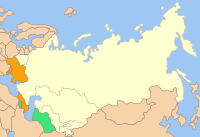
The Eurasian Economic Community (EURASEC), formerly the CIS Customs Union, was established by Russia, Belarus, Kazakhstan, Kyrgyzstan and Tajikistan. Ukraine and Moldova have observer status in the community; however, Ukraine has declared its desire not to become a full member state. Because having common borders with the rest of the community is a prerequisite for full membership, Moldova is barred from seeking it. Uzbekistan applied for membership in October 2005,[31] when the process of merging Central Asian Cooperation Organization and the Eurasian Economic Community began; it joined on 25 January 2006. Uzbekistan subsequently suspended its membership in 2008.[32]
On 10 October 2014 an agreement on the termination of the Eurasian Economic Community was signed in Minsk after a session of the Interstate Council of the EAEC. The Eurasian Economic Community was terminated from 1 January 2015 in connection with the launch of the Eurasian Economic Union.[33]
Customs Union of Belarus, Kazakhstan and Russia
Russia, Belarus, Kazakhstan created a customs union that entered into force in July 2010. Ukraine, Kyrgyzstan and Tajikistan indicated interest in joining at the time.[34][35] Russia has been eager for Armenia, Moldova and Ukraine to join the custom union instead of the European Union, and the Moldovan break-away state of Transnistria has supported this. In 2013, Kyrgyzstan and Armenia announced plans to seek membership, but division over the issue in Ukraine led to the 2014 Ukrainian revolution after the Ukrainian government backed out of an EU Eastern Partnership in favor of the union. In 2014, voters in the Moldovan autonomous region of Gagauzia rejected closer ties to the EU in favor of the union.[36]
On 1 January 2012, Russia, Kazakhstan and Belarus established the Single Economic Space which ensures the effective functioning of a single market for goods, services, capital and labour, and to establish coherent industrial, transport, energy and agricultural policies.[37][38] The agreement included a roadmap for future integration and established the Eurasian Economic Commission (modelled on the European Commission).[39] The Eurasian Economic Commission serves as the regulatory agency for the Eurasian Customs Union, the Single Economic Space and the Eurasian Economic Union.[37]
Eurasian Economic Union
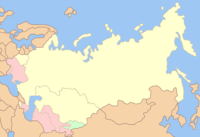
The Eurasian Economic Union is an economic union of post-Soviet states. The treaty aiming for the establishment of the EAEU was signed on 29 May 2014 by the leaders of Belarus, Kazakhstan and Russia, and came into force on 1 January 2015.[40] Treaties aiming for Armenia's and Kyrgyzstan's accession to the Eurasian Economic Union were signed on 9 October 2014 and 23 December respectively. Armenia's accession treaty came into force on 2 January 2015.[41] Although Kyrgyzstan's accession treaty will not come into force until May 2015, provided it has been ratified,[42] it will participate in the EAEU from the day of its establishment as an acceding state.[43][44][45][46][47] Moldova and Tajikistan are prospective members.
Collective Security Treaty Organization
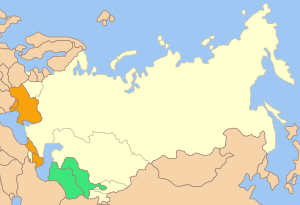
Seven CIS member states, namely Russia, Belarus, Kazakhstan, Kyrgyzstan, Tajikistan, Uzbekistan and Armenia, have enhanced their military cooperation, establishing the Collective Security Treaty Organization (CSTO), this being an expansion of the previous Collective Security Treaty (CST). Uzbekistan which (alongside Georgia and Azerbaijan) withdrew from the CST in 1999, joined GUAM. Then in 2005 it withdrew from GUAM and joined the CSTO in 2006. On 28 June 2012, Uzbekistan suspended its membership in the CSTO.[48]
North Atlantic Treaty Organization
Three former Soviet states are members of NATO: Estonia, Latvia and Lithuania. Georgia, where both public opinion and the ruling government favor NATO membership, is in the Intensified Dialogue program with NATO. Ukraine also declared joining NATO as its geopolitical goal once again in 2017 (first time being right after the Orange revolution and in the beginning of presidency of Viktor Yushchenko), after the presidency of Viktor Yanukovych, during which the government officially declared neutrality and ceased to seek NATO membership.[49][50]
Other states in the Partnership for Peace and Individual Partnership Action Plan program include Armenia, Azerbaijan, Belarus, Kazakhstan, Kyrgyzstan, Moldova, Russia, Tajikistan, Turkmenistan and Uzbekistan.
GUAM
Four member states, namely Georgia, Ukraine, Azerbaijan and Moldova established the GUAM group that was largely seen as intending to counter Russian dominance in the region. Notably, these four nations do not participate in any of the other regional organizations that sprang up in the region since the dissolution of the Soviet Union (other than the CIS).
Union of Russia and Belarus
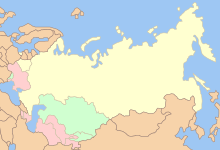
The Union of Russia and Belarus was originally formed on 2 April 1996 under the name Commonwealth of Russia and Belarus, before being tightened further on 8 December 1999. It was initiated by the president of Belarus, Alexander Lukashenko. On paper, the Union of Russia and Belarus intends further integration, beyond the scope of mere cooperation, including the introduction of the ruble as a common currency.
Other regional organizations
Economic Cooperation Organization
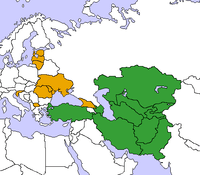
The Economic Cooperation Organization was originally formed in 1985 by Turkey, Iran and Pakistan but in 1992 the organization was expanded to include Afghanistan and the six primarily Muslim former Soviet republics: Azerbaijan, Kazakhstan, Kyrgyzstan, Tajikistan, Turkmenistan and Uzbekistan.
Community for Democracy and Rights of Nations
The post-Soviet disputed states of Abkhazia, Artsakh, South Ossetia, and Transnistria are all members of the Community for Democracy and Rights of Nations which aims to forge closer integration.
Community of Democratic Choice
The Community of Democratic Choice (CDC) was formed in December 2005 at the primary instigation of Ukraine and Georgia, and composed of six post-Soviet states (Ukraine, Georgia, Moldova, and the three Baltic states of Estonia, Latvia and Lithuania) and three other countries of Eastern and Central Europe (Slovenia, Romania and the Republic of Macedonia). The Black Sea Forum (BSF) is a closely related organization. Observer countries include Armenia, Bulgaria, and Poland.
Just like GUAM before it, this forum is largely seen as intending to counteract Russian influence in the area. This is the only international forum centered in the post-Soviet space in which the Baltic states also participate. In addition, the other three post-Soviet states in it are all members of GUAM.
Shanghai Cooperation Organisation
.svg.png)
The Shanghai Cooperation Organisation (SCO), is composed of China and five post-Soviet states, namely Russia, Kazakhstan, Kyrgyzstan, Tajikistan and Uzbekistan. The organization was founded in 2001, though its predecessor, the Shanghai Five grouping, has existed since 1996. Its aims revolve around security-related issues such as border demarcation, terrorism and energy.[51]
Economic cooperation organizations
- Central European Free Trade Agreement (CEFTA) with Moldova (it includes also non post-Soviet countries of the former Yugoslavia; previously, also included other Central European countries that left CEFTA when joining the European Union; CEFTA plays a role in Central Europe similar to what European Free Trade Association (EFTA) provides in Western Europe for non EU-members; this alliance an economical organization with strong cooperation with the European Union, for countries that do not want to participate in EurAsEC centered on Russia but that are seeking alliances to the West); even if Moldova is the only CEFTA country that is still within a weakening CIS, it no longer participates to the CSTO for most of the common security policy (but cannot join the EU because of incompatibility with WEU stability rules and the unsolved problem of Transnistria) but can still benefit from the Free Trade Area notably with Romania and Bulgaria (in the EU).
- Black Sea Economic Cooperation (BSEC) with Russia, Georgia, Ukraine, Azerbaijan, Moldova, Turkey, Albania, Greece, Romania, Bulgaria, Serbia and Armenia (an economic organisation closely related to the SCO but more focused regionally to include also Armenia; it also aims for the harmonious development of democracy for increasing the commerce in South-East Europe and includes some EU members, so it cannot be a regional free-trade union).
- The European Union (EU) with the three Baltic countries that were the first ones to declare independence from the former USSR and have never joined CIS after the collapse of USSR (it includes also now some post-communist countries in Central Europe, that have left CEFTA when entering the EU : Poland, Czech Republic, Slovakia, Hungary, Romania, Bulgaria and Slovenia).
Political integration and security alliances
- Stability Pact for South Eastern Europe (SPforSEE) with Moldova (similar in structure to CEFTA, but does not focus on economy but security, for those countries that are not NATO members); this organization largely cooperates with NATO, and is related to the group of observers at Western European Union (WEU).
- The North Atlantic Treaty Organization (NATO), for Baltic countries, Poland, and Central European countries that have also joined the EU (the EU membership includes also WEU membership because they follow the Common Foreign and Security Policy and European Security and Defence Policy policies shared now by the EU, the WEU and all European NATO members).
- The other remaining countries are those part of the former Yugoslavia, but their recent conflict and political tensions still does not allow them to cooperate efficiently for their political integration and for their mutual security; in addition, they still do not have full sovereignty in this domain (some of them are still under surveillance by EU or NATO, as mandated by UNO). They still need to find an internal stability and they can collaborate economically with the help of other organizations focusing on economy or political cooperation and development. However a more limited cooperation for security is possible through their membership to the larger Organization for Security and Co-operation in Europe (OSCE).
- The only exception is Belarus (whose post-soviet democratic transition did not occur) that still rejects political integration, and all security alliances with NATO, OSCE, WEU or other countries in Europe other than Russia (which the process of reintegration of Belarus has been tightened in almost all domains).
Organizations in other domains
- Southeast European Cooperation Process (SEECP) with Moldova (similar to SPforSEE, but focuses on political integration than cooperation for security, and to CEFTA but does not focus on trade).
- Southeast European Cooperative Initiative (SECI) with Moldova (closely related to SEECP).
- Central European Initiative (CEI) with Moldova, Ukraine and Belarus (and also Central and South-Western European countries in the European Union; it aims at helping Eastern European countries to reach the EU standards and cooperate politically and find a better economic development and a strong, working but more democratic legal system); it is the only regional organization where Belarus is still a member (but the political cooperation with Belarus is almost stalled, as it is the only country of the former Communist block country that balances in favor of stronger cooperation with Russia and against integration with EU and NATO ; however Belarus remains isolated and still does not cooperate too in the SCO group led by Russia and China).
- Black Sea Forum for Partnership and Dialogue (BSF) with Georgia, Ukraine, Azerbaijan, Moldova and Armenia (also non post-soviet countries that are NATO members, interested in their maintaining political stability and avoiding conflicts in the region: Romania, Bulgaria and Turkey, whose first two are also now EU and CEI members, using EU rules for their political development); however this organization does not focus on helping countries to join the EU, but reaching common standards and good governance and internal stability and democracy like in the CEI.
- None of these organizations are incompatible with the policy required for accessing EU membership in the domain of political cooperation and development.
- Merging the CEI and BSF is desired by Central European countries, that are members of both (often in addition to EU with stronger objectives) that would like to simplify the development process, and also members of the Council of Europe that federates (but at very slow pace) all European efforts of political cooperation and development through the various regional organizations.
- Community for Democracy and Rights of Nations
Other organizations
Apart from above, the former Soviet republics also hold membership in a number of multinational organizations such as:
Politics
Regarding political freedom in the former Soviet republics, Freedom House's 2015 report listed the following:
- Estonia, Latvia, and Lithuania as "free" countries.
- Armenia, Georgia, Kyrgyzstan, Moldova, and Ukraine were listed as "partly free."
- Azerbaijan, Belarus, Kazakhstan, Russia, Tajikistan, Turkmenistan, and Uzbekistan were listed as "not free", with Turkmenistan and Uzbekistan being noted as among the "worst of the worst".
Similarly, the Worldwide Press Freedom Index published by Reporters Without Borders in 2015, recorded the following as regards press freedom:
- A good situation in Estonia
- A satisfactory situation in Latvia and Lithuania
- Noticeable problems in Armenia, Georgia, Kyrgyzstan, and Moldova
- A difficult situation in Belarus, Kazakhstan, Russia, Tajikistan, and Ukraine
- A very serious situation in Azerbaijan, Turkmenistan, and Uzbekistan
It has been remarked that several post-Soviet states have not changed leadership since their independence, such as Nursultan Nazarbayev in Kazakhstan and Islam Karimov in Uzbekistan, until his death in September 2016. All of these had originally more limited terms but through decrees or referendums prolonged their stay in office (a practice also followed by Presidents Alexander Lukashenko of Belarus and Emomalii Rahmon of Tajikistan) Askar Akayev of Kyrgyzstan had likewise served as President since its independence until he was forced to resign as a result of the Kyrgyz revolution of 2005. Saparmurat Niyazov in Turkmenistan ruled from independence until his death in 2006, creating a personality cult around himself.
The issue of dynastical succession has been another element affecting the politics of some post-Soviet States. Heydar Aliyev, after constructing an extensive and ongoing cult of personality, handed the Presidency of Azerbaijan to his son, Ilham Aliyev. Theories about the children of other leaders in Central Asia being groomed for succession abound.[52] The participation of Akayev's son and daughter in the 2005 Kyrgyz parliamentary elections boosted fears of dynastic succession being used in Kyrgyzstan as well, and may have contributed to the anti-Akayev climate that led to his overthrow.
Separatist conflicts
Economic, political, national, military, and social problems have all been factors in separatism in the Post-Soviet space. In many cases, problems due to factors such as ethnic divisions existed before the fall of the Soviet Union, and upon the fall of the union were brought into the open.[53] Such territories and resulting military conflicts have so far been:
Current declared states
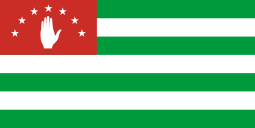
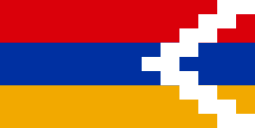
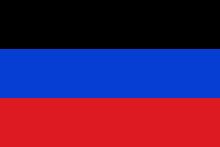

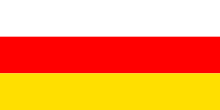
.svg.png)
Former declared states
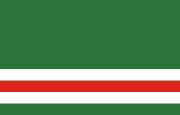
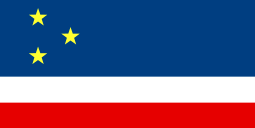
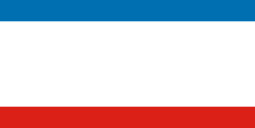
Civil wars
Civil wars unrelated to separatist movements have occurred twice in the region:
- The Georgian Civil War between the forces of Zviad Gamsakhurdia and Eduard Shevardnadze. The war ended after Russian forces intervened in support of Shevardnadze's government, which in turn agreed to join the Commonwealth of Independent States.
- The Tajikistani Civil War that lasted between 1992 and 1997.
Colour revolutions
Since 2003, a number of (largely) peaceful "colour revolutions" have happened in some post-Soviet states after disputed elections, with popular protests bringing into power the former opposition.
- The Rose Revolution in Georgia, leading to the fall from office of Eduard Shevardnadze.
- The Orange Revolution in Ukraine, bringing into power Viktor Yushchenko.
- The Tulip Revolution in Kyrgyzstan, leading to the resignation of Askar Akayev.
Russian population in post-Soviet states
There is a significant Russophone population in most of the post-Soviet states, whose political position as an ethnic minority varies from country to country.[67] While Belarus, Kazakhstan and Kyrgyzstan, in addition to Russia, have kept Russian as an official language, the language lost its status in other post-Soviet states after the end of the Soviet Union. It maintains semi-official status in all CIS member states, because it is the organisation's official working language, but in the three Baltic States, the Russian language is not recognized in any official capacity. Georgia, since its departure from the CIS in 2009, has begun operating its government almost exclusively in the Georgian language.
Religion
While the Soviet system placed severe restrictions on religious intellectual life, traditions continued to survive. After the dissolution of the Soviet Union, Islamic movements have emerged alongside ethnic and secular ones. Vitaly Naumkin gives the following assessment: "Throughout the time of change, Islam has served as a symbol of identity, a force for mobilization, and a pressure for democracy. This is one of the few social disasters that the church has survived, in which it was not the cause. But if successful politically, it faces economic challenges beyond its grasp."[68]
The Central Asian states (Kazakhstan, Kyrgyzstan, Tajikistan, Turkmenistan, and Uzbekistan) plus Azerbaijan from Southern caucasus are Muslim, except for their dwindling Russian and other European minorities. The Baltic States are historically Western Christian (Protestant and Roman Catholic), which adds another layer of pro-Western orientation to those countries, although the vast majority of what was the Protestant population (Estonia and northern Latvia) there is now irreligious. The dominant religion in the remaining former Soviet countries (Armenia, Belarus, Georgia, Moldova, Russia, and Ukraine) is Orthodox Christianity. In most countries, religiosity has increased since the Soviet collapse.
LGBT rights
Post-Soviet nostalgia
Ever since the dissolution of the Soviet Union a certain number of people have expressed a longing for the Soviet period and its values. The level of post-Soviet nostalgia varies across the former republics. For example, certain groups of people may blend the Soviet and post-Soviet experience in their daily lives..[69]
According to July 2012 polling in Ukraine by RATING, 42% of respondents supported the formation of a unified state of Ukraine, Russia and Belarus; earlier in 2012 this support had been 48%.[70]
A 2016 poll of Russian citizens conducted by Levada Center showed that the majority viewed the collapse of the USSR negatively and felt that it could have been avoided, and an even greater number would openly welcome a revival of the Soviet system.[71]
See also
References
- ↑ "Managing Conflict in the Former Soviet Union: Russian and American Perspectives". harvard.edu. 30 October 1997. Retrieved 2 December 2015.
- 1 2 Van Elsuwege, Peter (2008). From Soviet Republics to Eu Member States: A Legal and Political Assessment of the Baltic States' Accession to the EU. Studies in EU External Relations. 1. BRILL. p. xxii. ISBN 9789004169456.
- ↑ Smith, David James (2001). Estonia. Routledge. p. 20. ISBN 0-415-26728-5.
- ↑ The Russian Federation technically achieved de facto independence from the Soviet Union after ratifying the Belavezha Accords therefore, Russia became the internationally recognized successor state to the Soviet Union.
- ↑ Includes Crimea and Sevastopol.
- 1 2 Holds both presidency and executive powers since the former Prime Minister of Turkmenistan role was abolished.
- ↑ Transition: The First Ten Years – Analysis and Lessons for Eastern Europe and the Former Soviet Union, The World Bank, Washington, DC, 2002, p. 4.
- ↑ GDP decline: transition and Great Depression compared, Kalikova and Associates Law Firm, Kyrgyzstan. Retrieved 13 January 2009.
- ↑ Study Finds Poverty Deepening in Former Communist Countries, New York Times, October 12, 2000
- ↑ Scheidel, Walter (2017). The Great Leveler: Violence and the History of Inequality from the Stone Age to the Twenty-First Century. Princeton University Press. p. 222. ISBN 978-0691165028.
- ↑ "Death surge linked with mass privatisation". University of Oxford. 2009. Archived from the original on 2014-07-02. Retrieved 2015-06-28.
- ↑ Privatisation 'raised death rate'. BBC, 15 January 2009. Retrieved 19 November 2014.
- ↑ Rosefielde, Steven (2001). "Premature Deaths: Russia's Radical Economic Transition in Soviet Perspective". Europe-Asia Studies. 53 (8): 1159–1176. doi:10.1080/09668130120093174.
- ↑ IMF online database
- ↑ Ghodsee, Kristen (2017). Red Hangover: Legacies of Twentieth-Century Communism. Duke University Press. p. 63. ISBN 978-0822369493.
- ↑ Milanović, Branko (2015). "After the Wall Fell: The Poor Balance Sheet of the Transition to Capitalism". Challenge. 58 (2): 135–138. doi:10.1080/05775132.2015.1012402.
- ↑ "GDP growth (annual %)". worldbank.org. Retrieved 2 December 2015.
- ↑ "The World Factbook". cia.gov. Retrieved 2 December 2015.
- ↑ (nominal) GDP (official exchange rate), The World Factbook, Central Intelligence Agency, accessed on 19 March 2014. Population data obtained from Total Midyear Population Archived 2013-10-12 at the Wayback Machine., U.S. Census Bureau, International Data Base, accessed on 19 March 2014. Note: Per capita values were obtained by dividing the GDP (official exchange rate) data by the population data. The figures were then rounded to the nearest hundred in typical Factbook fashion.
- ↑ "The World Factbook". cia.gov. Retrieved 2 December 2015.
- ↑ "The World Factbook". cia.gov. Retrieved 2 December 2015.
- ↑ "Human Development Report 2016 – "Human Development for Everyone"" (PDF). HDRO (Human Development Report Office) United Nations Development Programme. pp. 198–201. Retrieved 2 September 2017.
- 1 2 Ratification status of CIS documents as of 15 January 2008 Archived October 30, 2008, at the Wayback Machine. (Russian).
- ↑ Turkmenistan reduces CIS ties to "Associate Member", Radio Free Europe/Radio Liberty, 29 August 2005.
- ↑ Georgian parliament votes to withdraw from CIS on BBC News, 14 August 2008.
- ↑ Statement of the Ministry of Foreign Affairs of Georgia on Georgia's withdrawal from CIS Archived September 3, 2008, at the Wayback Machine., 18 August 2008.
- ↑ CIS Charter, 22 January 1993 (unofficial English translation).
- ↑ Reuters (March 19, 2014). "Ukraine Says It Could Quit Russia-Led Bloc". Reuters. Retrieved Jan 14, 2015.
- ↑ RFE/RL (Oct 19, 2011). "Most CIS Countries Sign Up To Free-Trade Zone". RFE/RL. Retrieved Jan 14, 2015.
- ↑ Ian Carver (Jan 18, 2014). "Implications of CIS Free Trade Zone Expansion in Central Asia". New Eastern Outlook. Retrieved Jan 14, 2015.
- ↑ Sputnik (10 November 2005). "Working group discusses Uzbekistan's accession to EurAsEC". rian.ru. Archived from the original on May 1, 2013. Retrieved 2 December 2015.
- ↑ Sputnik (12 November 2008). "Uzbekistan suspends Eurasec membership, Moscow unruffled". rian.ru. Archived from the original on June 25, 2013. Retrieved 2 December 2015.
- ↑ Eurasian Economic Community Leaders Sign Group Abolition Agreement, putniknews.com. Retrieved 13 January 2015.
- ↑ RIA Novosti report, 6 July 2010, "Customs Union of Russia, Belarus, Kazakhstan to become fully operational" Archived September 27, 2010, at the Wayback Machine., retrieved 22 December 2010
- ↑ RIA Novosti report, 26 November 2010, "Ukraine eyes customs union with Russia, Kazakhstan, Belarus" Archived December 24, 2010, at the Wayback Machine., retrieved 22 December 2010
- ↑ "Gagauzia Voters Reject Closer EU Ties For Moldova". RadioFreeEurope/RadioLiberty. Retrieved 2 December 2015.
- 1 2 Ukraine cannot get observer status at Eurasian Econ Union due to Association Agreement with EU, Russia, Interfax-Ukraine (14 June 2013)
- ↑ Barron, Lisa (1 October 2013). "Belarus eases current account deficit with Customs Union, Common Economic Space". Cistran Finance. Retrieved 25 October 2013.
- ↑ Евразийские комиссары получат статус федеральных министров. Tut.By (in Russian). 17 November 2011. Retrieved 19 November 2011.
- ↑ Договор о Евразийском экономическом союзе
- ↑ Дмитрий. "ДОГОВОР О ПРИСОЕДИНЕНИИ РЕСПУБЛИКИ АРМЕНИЯ К ДОГОВОРУ О ЕВРАЗИЙСКОМ ЭКОНОМИЧЕСКОМ СОЮЗЕ ОТ 29 МАЯ 2014 ГОДА (Минск, 10 октября 2014 года)". customs-code.ru. Retrieved 2 December 2015.
- ↑ "Finalization of ratification procedures on Armenia's accession to EAEU to be declared in Moscow today". Public Radio of Armenia. Retrieved 2 December 2015.
- ↑ "Kyrgyzstan, Armenia officially enter Eurasian Economic Union". World Bulletin. 24 December 2014. Retrieved 26 December 2014.
Signed agreement opens up new possibilities for Kyrgyzstan and Armenia, starting from 1st January 2015
- ↑ "Putin said the accession of Kyrgyzstan to the EAEC" (in Russian). Life News. 23 December 2014. Retrieved 26 December 2014.
Kyrgyzstan is among the member countries of the Eurasian Economic Union (EAEC). Kyrgyzstan will participate in the governing bodies of the EAEC since the start of the Union - from 1 January 2015.
- ↑ "EAEC: stillborn union?" (in Russian). Deutsche Welle. Retrieved 26 December 2014.
Eurasian Economic Union added December 23 Armenia and Kyrgyzstan.
- ↑ Farchy, Jack (23 December 2014). "Eurasian unity under strain even as bloc expands". The Financial Times. Retrieved 26 December 2014.
Kyrgyzstan on Tuesday a signed a treaty to join the Eurasian Economic Union, expanding the membership of Moscow-led project to five even as its unity is strained by the market turmoil gripping Russia.
- ↑ "Eurasian Economic Union to Launch on January 1". The Trumpet. 24 December 2014. Retrieved 26 December 2014.
Russia, Belarus, Kazakhstan, Armenia and Kyrgyzstan agreed to a January 1 inauguration.
- ↑ "Uzbekistan Suspends Its Membership in CSTO". The Gazette of Central Asia. 29 June 2012. Retrieved 29 June 2012.
- ↑ Kizilov, Yevhen (8 June 2017). "Рада зробила пріоритетом для України вступ до НАТО" [Verkhovna Rada made joining NATO a priority for Ukraine] (in Ukrainian). Ukrayinska Pravda. Retrieved 14 February 2018.
- ↑ "Poroshenko: EU, NATO membership remains Ukraine's strategic goal, not prospect of 2018". UNIAN. 6 January 2018. Retrieved 14 February 2018.
- ↑ http://www.europarl.europa.eu/RegData/etudes/ATAG/2015/545718/EPRS_ATA(2015)545718_REV1_EN.pdf
- ↑ "Archived copy". Archived from the original on 2005-03-12. Retrieved 2005-04-05.
- ↑ http://www.colorado.edu/ibs/pec/johno/pub/PsgeTMR.pdf
- ↑ "Regions and territories: Abkhazia". BBC News. 12 March 2012.
- ↑ "Regions and territories: Nagorno-Karabakh". BBC News. 10 January 2012.
- ↑ "Regions and territories: South Ossetia". BBC News. 25 April 2012.
- ↑ "Trans-Dniester profile". BBC News. 26 December 2011.
- ↑ "Regions and territories: Chechnya". BBC News. 22 November 2011.
- ↑ Chinn, Jeff; Roper, Steven (1998). "Territorial autonomy in Gagauzia". Nationalities Papers. 26 (1): 87–101. doi:10.1080/00905999808408552.
But on 19 August 1990, the Gagauz elite, led by President Stepan Topal and Supreme Soviet Chairperson Mihail Kendighelean, quickly took the next step, declaring Gagauzia to be independent of Moldova and subject only to central Soviet authority
- ↑ Neukirch, Claus. "Autonomy And Conflict Transformation: The Case Of The Gagauz Territorial Autonomy In The Republic Of Moldova" (PDF). European Centre for Minority Issues. Archived from the original (PDF) on 2014-10-14. Retrieved 2014-10-09.
On 12 November 1989, a "Gagauz Autonomous Soviet Socialist Republic" was proclaimed by an assembly in Comrat ... In reaction to the Moldovan declaration of sovereignty, on 19 August 1990 the Gagauz leadership proclaimed a "Gagauz Soviet Socialist Republic", which would be independent from Moldova, but part of the Soviet Union ... on 23 December 1994 the Moldovan Parliament passed the "Law on the Special Juridical Status of Gagauzia (Gagauz-Yeri)"
- ↑ Zabarah, Dareg (2012). "Opportunity structures and group building processes: An institutional analysis of the secession processes in Pridnestrovie and Gagauzia between 1989 and 1991". Soviet and Communist studies. 45 (1–2).
According to the first point of its declaration, the Gagauz Republic "is a sovereign, socialist, soviet and multinational state
- ↑ Herszenhorn, David; Kramer, Andrew (19 March 2014). "Ukraine Plans to Withdraw Troops From Russia-Occupied Crimea". New York Times. Retrieved 6 August 2014.
- ↑ "Putin acknowledges Russian military serviceman were in Crimea". RT. 17 April 2014. Retrieved 13 August 2014.
- ↑ "Vladimir Putin in TV denial that Russian special forces are in eastern Ukraine". The Daily Telegraph. 17 April 2014. Retrieved 13 August 2014.
- ↑ "Russian Special Forces Storm Crimea Base". Sky News. 23 March 2014. Retrieved 13 August 2014.
- ↑ "Ukraine PM rejects Crimea referendum, vows to defend country". CBC News. 6 March 2014. Retrieved 6 August 2014.
- ↑ Robert Greenall, Russians left behind in Central Asia, BBC News, 23 November 2005.
- ↑ Naumkin, Vitaly (November 1992). "Islam in the States of the Former USSR". Annals of the American Academy of Political and Social Science. 524: 131–142. doi:10.1177/0002716292524001011.
- ↑ See: Kaprans, M. (2009) Then and now: Comparing the Soviet and Post-Soviet experience in Latvian autobiographiesKeywords 2.
- ↑ The language question, the results of recent research in 2012, RATING (25 May 2012)
- ↑ Most Russians regret USSR collapse, dream of its return, poll shows. RT. 19 April 2016.
External links
- Candid photos of the Eastern Bloc September–December 1991, in the last months of the USSR
- New Directions Post-Independence from the Dean Peter Krogh Foreign Affairs Digital Archives
- Post-Soviet Russia and its Neighbor States from the Dean Peter Krogh Foreign Affairs Digital Archives
- Discovering The Centuries-Old State Tradition, professor Pål Kolstø, University of Oslo
- Former Soviet war zones |The hazards of a long, hard freeze, The Economist, 19 August 2004
- 4 enclaves' post-Soviet fate in limbo, The Seattle Times, 20 August 2006
- Are Independence Referendums First Step Toward Kremlin's 'Historical Revanchism'?, Radio Free Europe, 15 September 2006


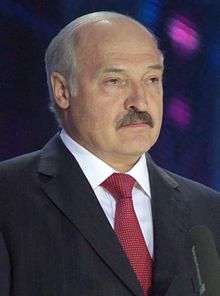

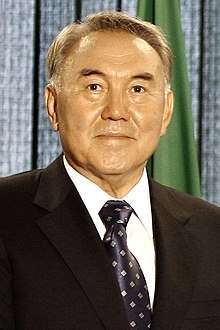
.jpg)
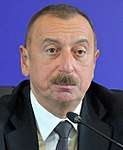
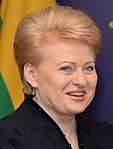
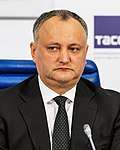
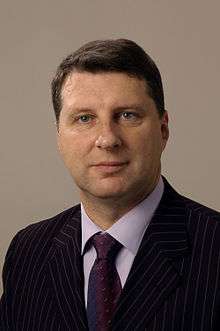

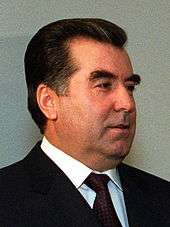
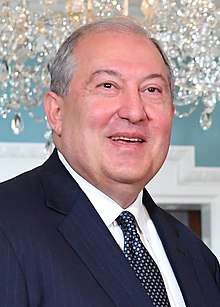
_02.jpg)
.jpg)

.jpg)
.jpg)
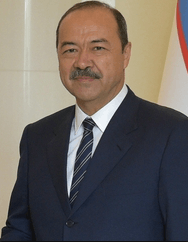
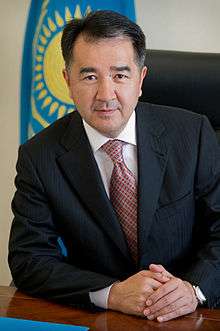
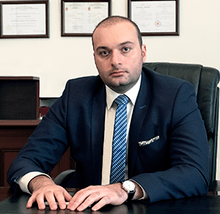
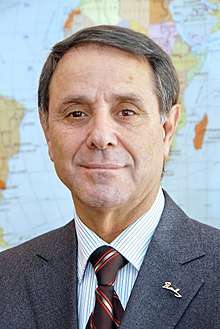
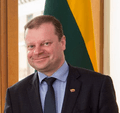
_cropped.jpg)

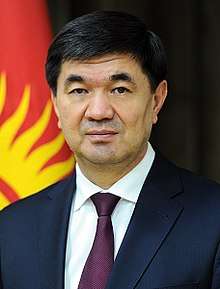
.jpg)
.jpg)
